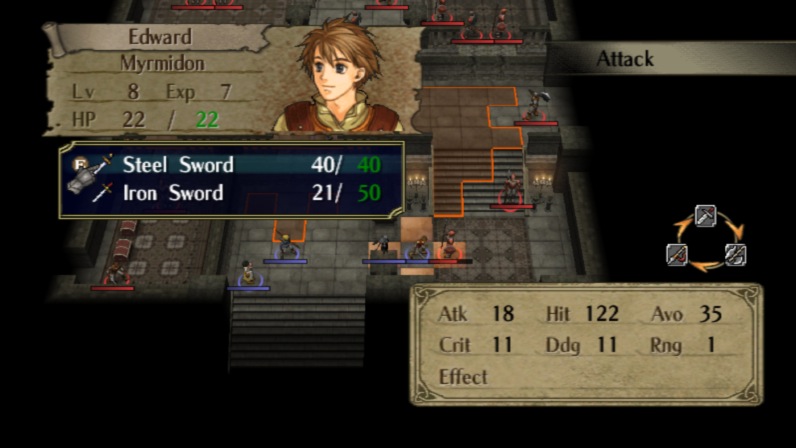Part 7: (Game Mechanics) Fuckin' weapons, how do they work?
Since we're already talking about weapons, and since it'll be a few days before I'm reunited with my PC, and since it's been a while since the last one,Let's Talk About Game Mechanics!
Episode the Second: Fuckin' weapons, how do they work?
Weapons are awesome. They let you kill people. The right weapon on the right unit at the right time can mean the difference between a one hit kill and the enemy surviving to take another chunk of your health that you can't afford to lose.
So let's talk about weapons!
Yet More Numbers:
All weapons, regardless of variety and classification, are defined by the same few numbers.

The first entry is the weapons Type and Rank, in this case, "Light" and "E". In order to actually be able to use the weapon, the user must have the appropriate rank in the appropriate category. E is the lowest rank, SS the highest. Different classes have different maximum ranks in different categories, so a few exceptional weapons can only be used by a very small number of people.
Might (Mt) is the base power of the weapon. It is added to the user's strength or magic (as appropriate) to produce the Atk stat, determining combat damage. One extra Mt literally translates to one extra point of damage.
Hit is the base chance to hit, and is a component of a unit's hit chance.
Crit is the base chance to crit, and is a component of a unit's crit chance.
Weight (Wt) is the amount of Strength a unit needs to wield the weapon without taking a penalty to attack speed. If you use a weapon that has more weight than you have strength, you'll pay the difference in AS. For fast units, this means a loss of ability to double-hit. For slower units, this means a vastly increased chance of being doubled.
Finally, certain weapons, either by virtue of their type or a unique attribute, are Effective against certain units (eg, the Thani tome is effective against armoured and mounted units). Against these units, effective weapons' might is tripled in any calculations. Be mindful of the other statistics of these weapons, however, because their effectiveness at one purpose is normally offset by a major drawback - typically they'll be very heavy.
Weapon Varieties:
The different classes of weapons have their own tendencies towards favoring certain kinds of use - beyond the simple facts of what units are capable of equipping them. The specifics of each weapon and each unit are of far more importance, but the tendencies give you some idea of what to expect.
Swords tend to shun power in favour of lightness and accuracy, having generally lower weight than equivalent weapons of other types. There are more swords with non-zero crit rates than other martial weapons.
Axes tend to be powerful, but heavy and inaccurate. Wielding axes while lacking the requisite strength will slow you down a lot.
Lances are balanced, being more powerful than swords and lighter than axes.
Knives are very weak but very light. They are usually only used by thieves and promoted variants thereof.
Bows are… well… bows. They are in their own little bubble without company or comparison.
Strikes are… different. Let's just say that "strategy" doesn't really come into Strike weapons, and leave it at that.
Magic also comes in similar variations; Wind Magic is analogous to swords, Thunder Magic is analogous to axes, and Fire Magic is analogous to lances. Light Magic is like to knives; being used primarily by healing classes who gain offensive capabilities on promotion, and Dark Magic is kinda its own thing.
Staves are not supposed to be used as weapons, but can be used by healers to counterattack in a pinch. Staves have zero might, however, so you're unlikely to do any damage this way. For some reason, they have an uncommonly high critical hit chance.
Weapon Matchups:
What has three sides, and all of em' pointy? That's right, a Weapon Triangle, a mainstay of Fire Emblem since Fire Emblem 4.
The Weapon Triangle is the Rock-Paper-Scissors style relationship that several weapons share. Wielding certain weapons against certain other weapons will often give a bonus to one weapon and a penalty to the other. While the matchups are the same in all Fire Emblem games that feature them, the numbers are a little different in each iteration.

Depicted on the right hand side of the screen is the picturebook version; but here's the text; swords beat axes, axes beat lances, lances beat swords.
A similar relationship exists for magic; light magic beats dark, dark magic beats anima, and anima magic beats light (and a sub-triangle exists for anima magic; wind beats thunder, thunder beats fire, fire beats wind).
If the weapons being used in a given round of combat are both in a triangle, the unit with the advantaged weapon will receive a bonus of +1 Atk and +10 Hit, while the unit with the disadvantaged weapon will receive a penalty of -1 Atk and -10 Hit. If the weapons being used are not in a triangle (eg, a martial weapon vs magic or anything vs a knife) then there are no bonuses.
Oh, and the Weapon Triangle is completely disabled in Hard Mode because Hard Mode is full of stupid tweaks like that.
Funfact™: Fire Emblem (7) featured a few special weapons that inverted the Weapon Triangle (ie, an axe that was strong against swords and weak against lances) AND doubled the Triangle bonus to boot (thanks Staticpulse). It played very nicely into the way that in Fire Emblem 7 it takes a little more effort to see what weapon an enemy has, and that, combined with the fact that Fire Emblem 7's default Triangle bonus was ±15% hit along with the usual ±1 damage bonus, made for a very nasty surprise to anyone who wasn't careful.